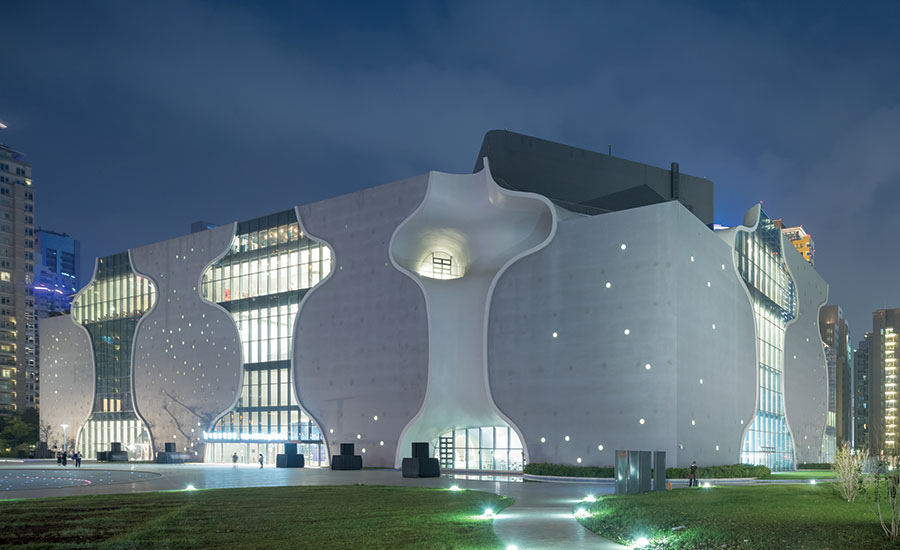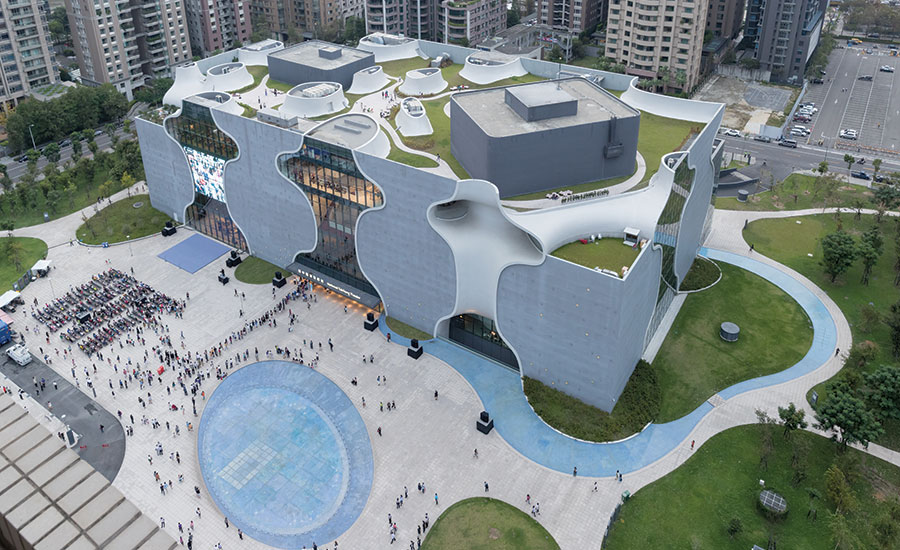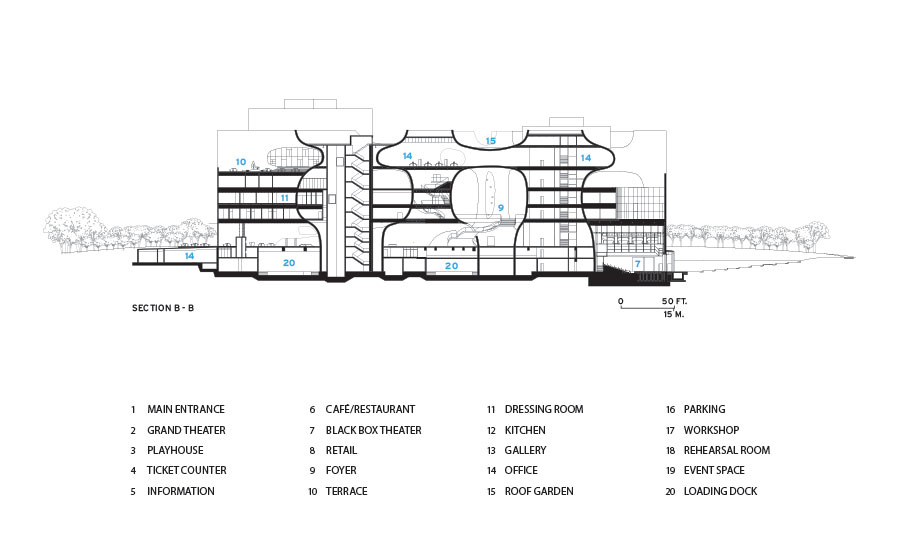National Taichung Theater
More than a decade in the making, Toyo Ito’s masterwork redefines the relationship between form, space, and structure.
When it comes to structural daring, few architects can top the Tokyo-based designer and 2013 Pritzker laureate Toyo Ito. After 11 years and $135 million, his most ambitious work to date has finally opened in Taichung City, a metropolis of 2.75 million people in central Taiwan. Situated majestically at the end of a tree-lined parkway, the 551,000-square-foot National Taichung Theater (NTT) is the city’s new center for opera and theater of all sorts. Though the NTT’s main attractions are its three theaters, these are upstaged by the drama of its architecture everywhere in between. Barely contained by the boxy enclosure of its concrete-and-glass skin, hourglass-shaped volumes define the interior of Ito’s building. These sinuous forms cinch in and balloon out with remarkable plasticity, the inside wall of one doubling as the outer surface of the neighboring space. Together these tubelike elements create a spectacular interior dreamscape of deep caverns and soaring canyons within the building.

In elevation, Ito expresses these tubes in silhouette, which accounts for the structure’s bold appearance. Conceptually, the building shell simply contains the interior, as if the system of tubes would continue were it not for the enclosure. In theory, says Ito, the four facades are not really facades: “They are sectional cuts.” And while the serpentine shapes dominate the otherwise rectilinear exterior, it is indoors where visitors are immediately swept up by the experience of Ito’s architecture, with dynamic, curving surfaces that pull you in, and a mysterious play of light and dark that makes you stop and wonder.

Picking up where the landscaped boulevard leaves off, a monumental plaza leads to the NTT’s main entrance, but additional doorways draw visitors from multiple directions. All open onto the lobby, a vast hall that seems like an extension of the city in scale and function. Filling the entire ground level, its tunnel-like spaces segue from one to another. Furniture designates administrative and commercial areas, including the ticket desk, café, and an open marketplace. Separate stairways lead to each of the building’s three venues: the 2,000-seat Grand Theater and 800-seat Playhouse, both entered from second-floor foyers, or the basement-level Black Box, a 200-seat theater that opens to an outdoor amphitheater via sliding doors. On the fifth floor, there is a gallery, restaurant, retail area, and office space, topped by the roof garden, where the tubular forms, some holding HVAC equipment,
poke out from the building.

poke out from the building.

Behind this structure’s bold expression is a complex story, one that began in 2004 when Ito entered a competition for the Ghent Music Forum. Inspired by the texture of that medieval Belgian city, he proposed a labyrinth of caves composed of a continuum of spaces, both horizontal and vertical. Though Ito lost that commission, he won the NTT competition the next year with a scheme based on the same visionary strategy.


Ito and his team adapted the Ghent concept for the NTT’s complex program, utilizing a malleable matrix of metal mesh tubes to devise a study model. They manipulated these tubular forms by hand to incorporate the spatial needs of the program. The final result of this study was a composition of 58 irregularly shaped tubes, which Ito calls catenoids, that eventually became the building’s curvaceous volumes. To translate these catenoid shapes into a quantifiable form, Ito’s team created what the architect terms an “emerging grid,” which consisted of five two-dimensional grids overlaid on each other, each one shifted slightly. This enabled the team to identify 423 control points. They then used these points to formulate a 3-D matrix that defined a planar shape and a position for each catenoid, breaking them down into connected flat planes. The architects then rounded the flat sides of the hollow forms and the whole confluence blended together. “The geometry came first, and then we forcibly introduced the theaters,” explains Ito.

Just finding a willing contractor took a year and a half. “No one wanted to do it,” laughs Ito. The construction team began to build the catenoids using a truss wall system, developed in Japan by the Asahi Building Wall Company, to provide the reinforcement. First they created two-dimensional trusses, each one curved differently. These ribs were upended, spaced 8 inches apart, and tied together into three-dimensional units that were joined. The assemblies were then sandwiched between layers of steel mesh, which replaced the typical concrete formwork. After a period of partial curing, the mesh forms were removed to minimize surface irregularities. Also intended to mask flaws, thin layers of mortar and textured white paint were applied to finish the 18-inch-thick walls on each side. Serving as both the building’s support and space-articulation systems, the walls are a complete integration of architecture and structure.



 To maximize floor area, horizontal plugs made of steel deck and concrete were placed within the resulting volumes. Since the cross-sections of the tubular elements are variable, the desired ceiling heights and floor area determined the locations of the inserts, which are supported by supplemental beams. Vertical concrete plugs were also used to add walls where needed and to fortify the weakness inherent in the cut edges visible on the elevations. Plugs within the plugs—circular glass disks set into the exterior concrete panels—admit a modicum of daylight, while downlights embedded in the suspended ceilings softly illuminate the interior.
To maximize floor area, horizontal plugs made of steel deck and concrete were placed within the resulting volumes. Since the cross-sections of the tubular elements are variable, the desired ceiling heights and floor area determined the locations of the inserts, which are supported by supplemental beams. Vertical concrete plugs were also used to add walls where needed and to fortify the weakness inherent in the cut edges visible on the elevations. Plugs within the plugs—circular glass disks set into the exterior concrete panels—admit a modicum of daylight, while downlights embedded in the suspended ceilings softly illuminate the interior.
 A direct reference to Ito’s design for the Ghent Music Center, the NTT is also an extension of the architect’s earlier built work. Both the cut elevations and the catenoids are reminiscent of his Sendai Mediatheque (RECORD, May 2001) whose undulant, hollow columns revealed by the building’s glass elevations made big waves when the project opened in 2001. Yet the National Taichung Theater pushes all of those ideas to much greater extremes. So, if an over-the-top operatic performance of Carmen or Rigoletto dosn’t transport patrons to another world, the building’s architecture surely will.
A direct reference to Ito’s design for the Ghent Music Center, the NTT is also an extension of the architect’s earlier built work. Both the cut elevations and the catenoids are reminiscent of his Sendai Mediatheque (RECORD, May 2001) whose undulant, hollow columns revealed by the building’s glass elevations made big waves when the project opened in 2001. Yet the National Taichung Theater pushes all of those ideas to much greater extremes. So, if an over-the-top operatic performance of Carmen or Rigoletto dosn’t transport patrons to another world, the building’s architecture surely will.
Commentaires
Enregistrer un commentaire